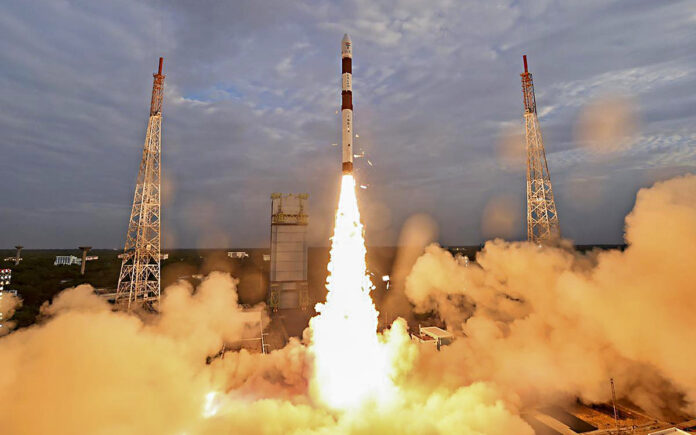New Delhi/New York: India is strategizing to establish a foothold in the competitive commercial space sector by focusing on the analysis of space data, constructing small satellites, and launching them affordably into orbit. Rather than directly challenging established players like SpaceX, India aims to provide cost-effective services and hardware to critical sectors such as communications, agriculture, and commodities, where high-quality data is an invaluable asset.
The stakes are significant, with the global launch market projected to reach $14.54 billion by 2031, accompanied by a data services market estimated at $45 billion by 2030. “The world has gone from satellites the size of a Boeing plane to the size of a laptop,” stated AK Bhatt, director general of the Indian Space Association, an industry organization. “This is a sector that India can win, instead of challenging heavy launches where Elon Musk has dominance. The country already has a historical advantage in data mining and interpretation.”
Since February, India has opened its space sector to private enterprises and established a 10 billion rupee ($119 million) venture fund to support space startups. The government has also announced plans for crewed space exploration and a mission to Venus, but the primary focus remains on developing commercial ventures.
However, India faces significant challenges. Countries like Japan and China have advanced space industries with ambitions for low-cost launches. Spaceflight is inherently difficult, and the global startup landscape is littered with failed boosters and satellite designs. “The tech is there and the ability is there… but space is tricky and very competitive, and while private companies have shown that they can create a niche for themselves, we need more proof of concept,” remarked Namrata Goswami, a space policy expert at Arizona State University. She emphasized that the Indian government must act as an “anchor customer” for the private sector.
Most of the anticipated revenue growth is expected to stem from downstream data applications, according to Pawan Goenka, chairman of IN-SPACe, India’s space regulatory body. These applications involve processing data from orbit to enhance agricultural productivity, develop more accurate navigation systems, improve telecommunications, strengthen border security, and combat climate change, Goenka elaborated.
Indian companies such as Bellatrix Aerospace, Pixxel, Agnikul Cosmos, Dhruva Space, and others are already engaged in building or launching small satellites and satellite components. Last month, India’s space agency, ISRO, completed the third and final developmental flight for its Small Satellite Launch Vehicle, which will soon be transferred to private firms. “The end uses of Earth observation are vast,” Goenka noted. “What we are doing is addressing various parts of the puzzle.”
For instance, Bengaluru-based SatSure has been supplying near real-time satellite data to the Airports Authority of India to improve air traffic management and safety, which has enabled airlines to reduce fuel costs through optimized flight planning. This initiative is projected to save 37.5 billion rupees ($446 million) in fuel costs for airlines annually by 2025 and will lead to a roughly 70% reduction in airport process planning timelines, according to the authority.
Earth observation (EO) satellites, equipped with cameras and sensors, could unlock similar savings across other sectors, as noted by the company’s CEO, Prateep Basu. “EO is solving problems that span across utilities, navigation, trading, industries, helping save millions of dollars,” Basu explained.
Also Read | Moon Mission: Competition and Collaboration at the IAC in Milan
Government Initiatives
Since the market was opened, companies both large and small have entered the space sector, with legacy IT firms like Infosys investing in satellite imaging company GalaxEye Space Solutions. Google-backed Pixxel has secured contracts with NASA, while Baring- and Promus-backed SatSure has taken on clients such as HDFC Bank and global seed company Syngenta. Dhruva Space has become one of the first companies to receive permission to operate satellite communication centers on Earth, a domain previously monopolized by ISRO.
“India is a software powerhouse and produces some of the best minds in the world in data science, machine learning, and artificial intelligence. The space downstream market is, at the end of the day, a software play,” asserted Aravind Ravichandran, founder of France-based advisory firm Terrawatch Space.
Also Read | Pakistan in Lockdown Mode: Schools and Colleges Shut Down, Marriages Banned Due to Security Concerns
The consultancy Euroconsult projects that between 2023 and 2032, approximately 26,104 small satellites—weighing less than 500 kilograms (1,100 lb)—will be launched, averaging 1.5 tons of daily launch mass. The firm anticipates that the overall small satellite industry will be valued at $110.5 billion in the next decade.
Indian space companies have already seen a surge in funding, with $126 million raised in 2023, marking a 7% increase from the $118 million raised in 2022 and a 235% increase from $37.6 million in 2021, according to Tracxn data. However, India holds only about 2% of the market share in commercial space activities, with demand still largely reliant on global clients, and well-established companies from the U.S., Russia, and China presenting formidable competition.
“To truly make a dent, (Indian) solutions have to scale to the rest of South Asia and then to the rest of the world,” said Pixxel founder and CEO Awais Ahmed.



